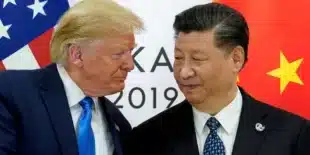China’s exports in May experienced their highest growth rate in over a year, despite ongoing trade tensions. According to customs data released on Friday, exports surged 7.6% year-on-year to $302.35 billion, marking the fastest pace since April 2023. However, imports only increased by 1.8% to $219.73 billion, falling short of the anticipated 4% growth.
The notable rise in exports is partly attributed to a lower base from the previous year, when exports had decreased by 7.5%. In comparison, April saw a 1.5% growth in exports and an 8.4% rise in imports year-on-year. This robust export performance widened China’s trade surplus to $82.62 billion from April’s $72.35 billion.
This export growth comes amid heightened trade tensions with the U.S. and Europe, with the U.S. increasing tariffs on Chinese-made electric vehicles and Europe considering similar actions. Zichun Huang of Capital Economics noted that foreign tariffs might not immediately threaten exports; they could potentially boost them as firms expedite shipments to avoid duties. Huang also mentioned that a weaker real effective exchange rate would support exports.
Import volumes remained relatively stable last month, but they are expected to increase soon due to increased government spending on the import-intensive construction sector.
The Association of Southeast Asian Nations (ASEAN) remains the largest market for Chinese products, with exports to ASEAN countries growing 9.7% year-on-year to $50.83 billion from January to May. Exports to the U.S. saw a slight increase of 0.2% in the same period, while exports to the European Union fell by 3.9%.
The fastest-growing export categories included steel, automobiles, home appliances, and ships, with automobiles experiencing the highest growth rate. China exported 569,000 cars in the first five months of the year, a 26.8% increase compared to the previous year.
China faces allegations from the U.S. and the European Union of overproducing and flooding markets with inexpensive electric vehicles, prompting both to consider imposing tariffs. China is also concerned that such duties could further reduce exports amid weakening domestic demand.
Lynn Song of ING Economics warned that aggressive tariffs on strategic exports and automobiles could lead to retaliation and increased trade tensions. Song expressed caution about the trade outlook for the second half of the year, predicting a decline in trade’s contribution to economic growth.
Factory activity in China slowed more than expected in May, with the manufacturing purchasing managers index dropping to 49.5 from 50.4 in April, indicating contraction.
China is striving to recover from the COVID-19 pandemic but faces challenges due to weaker global demand and a slump in its property sector. The country has set an economic growth target of around 5% for this year, which economists believe will require additional policy support.


